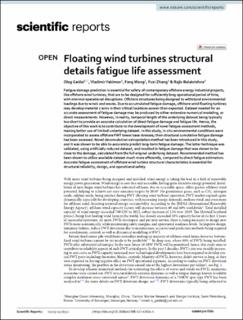| dc.contributor.author | Gaidai, Oleg | |
| dc.contributor.author | Yakimov, Vladimir | |
| dc.contributor.author | Wang, Fang | |
| dc.contributor.author | Zhang, Fuxi | |
| dc.contributor.author | Balakrishna, Rajiv | |
| dc.date.accessioned | 2023-12-29T14:01:00Z | |
| dc.date.available | 2023-12-29T14:01:00Z | |
| dc.date.created | 2023-10-26T10:36:48Z | |
| dc.date.issued | 2023 | |
| dc.identifier.citation | Gaidai, O., Yakimov, V., Wang, F., Zhang, F. & Balakrishna, R. Floating wind turbines structural details fatigue life assessment. Scientific Reports, 13 (1) | en_US |
| dc.identifier.issn | 2045-2322 | |
| dc.identifier.uri | https://hdl.handle.net/11250/3109162 | |
| dc.description.abstract | Fatigue damage prediction is essential for safety of contemporary offshore energy industrial projects, like offshore wind turbines, that are to be designed for sufficiently long operational period of time, with minimal operational disruptions. Offshore structures being designed to withstand environmental loadings due to winds and waves. Due to accumulated fatigue damage, offshore wind floating turbines may develop material cracks in their critical locations sooner than expected. Dataset needed for an accurate assessment of fatigue damage may be produced by either extensive numerical modeling, or direct measurements. However, in reality, temporal length of the underlying dataset being typically too short to provide an accurate calculation of direct fatigue damage and fatigue life. Hence, the objective of this work is to contribute to the development of novel fatigue assessment methods, making better use of limited underlying dataset. In this study, in-situ environmental conditions were incorporated to assess offshore FWT tower base stresses; then structural cumulative fatigue damage has been assessed. Novel deconvolution extrapolation method has been introduced in this study, and it was shown to be able to accurately predict long-term fatigue damage. The latter technique was validated, using artificially reduced dataset, and resulted in fatigue damage that was shown to be close to the damage, calculated from the full original underlying dataset. Recommended method has been shown to utilize available dataset much more efficiently, compared to direct fatigue estimation. Accurate fatigue assessment of offshore wind turbine structural characteristics is essential for structural reliability, design, and operational safety. | en_US |
| dc.language.iso | eng | en_US |
| dc.publisher | Springer Nature Switzerland AG | en_US |
| dc.rights | Navngivelse 4.0 Internasjonal | * |
| dc.rights.uri | http://creativecommons.org/licenses/by/4.0/deed.no | * |
| dc.subject | vindturbiner | en_US |
| dc.subject | flytende vindturbiner | en_US |
| dc.title | Floating wind turbines structural details fatigue life assessment | en_US |
| dc.type | Peer reviewed | en_US |
| dc.type | Journal article | en_US |
| dc.description.version | publishedVersion | en_US |
| dc.rights.holder | © 2023 The Author(s). | en_US |
| dc.subject.nsi | VDP::Teknologi: 500 | en_US |
| dc.source.pagenumber | 0 | en_US |
| dc.source.volume | 13 | en_US |
| dc.source.journal | Scientific Reports | en_US |
| dc.source.issue | 1 | en_US |
| dc.identifier.doi | 10.1038/s41598-023-43554-4 | |
| dc.identifier.cristin | 2188707 | |
| cristin.ispublished | true | |
| cristin.fulltext | original | |
| cristin.qualitycode | 1 | |

